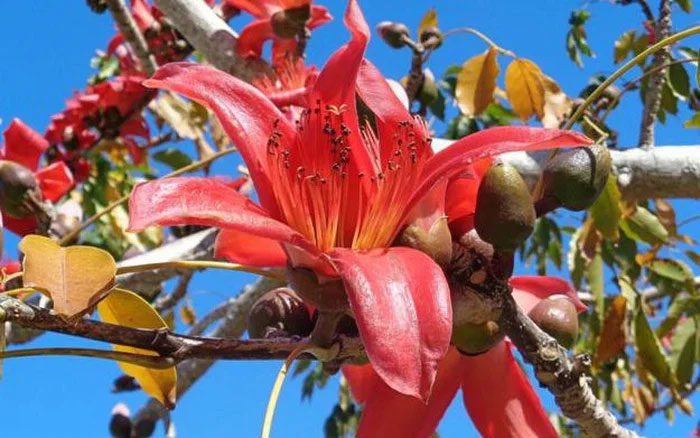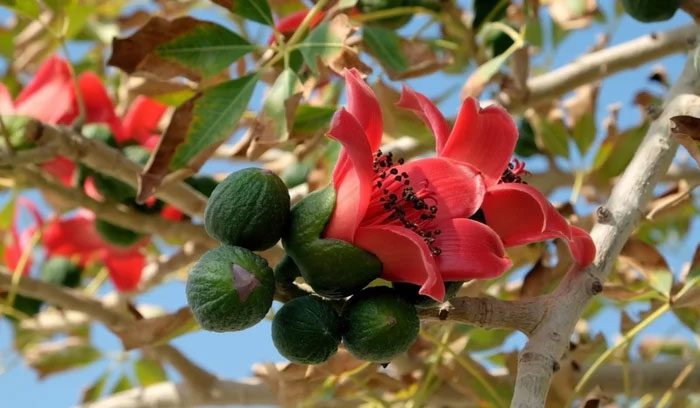In March and April, the silk cotton tree blossoms begin to bloom, signaling the arrival of summer. The silk cotton flower has numerous health benefits and is used as a remedy in traditional medicine. However, very few people are aware of the uses of this flower.
Uses of the Silk Cotton Flower
Characteristics of the Silk Cotton Tree
The silk cotton tree, known by various names such as Bombax, is a hardwood tree that is perennial, fast-growing, reaching heights of 20 to 25 meters, and spreading 8 to 15 meters wide. Its compound leaves are fern-like, and its roots are robust, penetrating deeply into the ground with strong adhesion. The flowers grow on small branches and have five bright red petals. The fruit is capsule-shaped, containing cotton fibers inside. The seeds are egg-shaped and covered with smooth white hairs.
Each part of the silk cotton tree contains beneficial compounds: the seeds contain 20-26% fat, including stearin. The bark is rich in mucilage. The roots contain galactose, arabinose, tannins, cephalin, fats, proteins, and red samuel, while the silk cotton flower is abundant in amino acids, pectin, tannins, sugars, and various trace elements.
Therefore, almost every part of the silk cotton tree is used for medicinal purposes, with the roots and flowers often utilized to support the treatment of various conditions.

Almost every part of the silk cotton tree can be used as medicine. (Image: Internet).
What are the effects of the Silk Cotton Flower?
According to traditional medicine, the silk cotton flower has a bitter, slightly sweet taste and a cooling property, making it useful for anti-inflammatory, antiseptic, and blood circulation support. It assists in treating diarrhea, dysentery, stomach ulcers, heatstroke, and wound healing.
Here are some folk remedies using the silk cotton flower and its parts that are easy to make and suitable for the season:
Supports Treatment of Diarrhea
The silk cotton flower is very effective in addressing diarrhea or loose stools. You can boil the leaves, soft stems, or flowers of the tree in about 500ml of water, reducing the volume by half, and divide it into two doses to drink throughout the day.
Supports Treatment of Boils and Swelling
Simply take fresh silk cotton flowers, pound them into a paste, and apply it to the affected areas of skin with boils and swelling. Repeat this once a day and continue until symptoms improve.
Supports Treatment of Arthritis and Stomach Ulcers
People can use about 15 to 30g of the roots, stems, or flowers of the silk cotton tree to brew tea. Additionally, combining the roots, stems, and flowers with 6g of the roots of the two-sided needle plant can also be effective. Brew this mixture and drink it twice a day.
Supports Treatment of Joint Pain
To relieve joint pain, use 50g of fresh silk cotton plant, peel the outer skin, then pound it and mix it with vinegar, applying the mixture to the painful joint areas.

When using the silk cotton tree as a remedy, consult a doctor first. (Image: Internet).
For sprains, combine the fresh bark of the silk cotton tree, fresh pennywort, fresh elephant trunk herb, and fresh dandelion. Wash all ingredients thoroughly, pound them, and then wrap them around the swollen area.
If swelling occurs due to injury, you can soak the stems or roots of the silk cotton tree in alcohol and then apply it to the affected skin area. Additionally, drinking alcohol infused with the roots of the silk cotton tree can help treat chronic arthritis, back pain, and knee pain. However, only consume a small amount of the infused alcohol each time.
Besides the remedies mentioned above, the silk cotton tree is also used in other recipes such as:
- For women with low milk supply: use 12-15g of silk cotton seeds boiled into tea.
- For toothache: use 20g of the bark of the silk cotton tree, brew it strong, and gargle daily.
- For cough with excessive phlegm due to lung heat: use 15g of silk cotton flowers combined with 15g of water spinach and 10g of white mulberry, and brew to drink.
Some Precautions When Using the Silk Cotton Flower as a Remedy
Although the silk cotton flower has many health benefits, there are some important considerations to keep in mind when using this flower:
- When using the silk cotton tree for medicinal purposes, it’s advisable to consult a doctor or traditional medicine practitioner to avoid incorrect usage or overdose, which could seriously affect health.
- The silk cotton tree only supports the treatment of certain conditions and cannot replace a doctor’s prescriptions.
- If you experience any unusual symptoms after consuming the silk cotton flower’s parts, you should stop using it and seek medical attention.
In summary, the silk cotton flower has various uses, and you can take advantage of its blooming season to prepare dishes or remedies. However, it should be used in moderation, and it is advisable to consult experts for guidance.


















































